The Nathu La Pass in the Tibet autonomous region received this year’s first officially organised group of Indian pilgrims on Wednesday.
The 38 pilgrims will travel to Mansarovar Lake and Mount Kailash in the region’s Ngari prefecture in the following 12 days. Both sites are regarded as sacred by Hindus, Buddhists, Jains and Tibetan Bon practitioners.
Advertisement
This year, the pass is expected to see about 500 such pilgrims from India making the 2,874-kilometer pilgrimage, said Yang Zhigang, deputy director of the office of foreign affairs and overseas Chinese affairs in Xigaze, the region’s second-biggest city.
“The pilgrims will be provided with room and board, as well as medicines and other help in their journey,” Yang said.
Hotel rooms are arranged in the region’s counties of Kangmar, Lhaze and Drongba, and the pilgrims need to pay for accommodations, according to the office.
Vegetables, fruit and some basic rescue facilities are also prepared for their needs.
Anuj Gupta made the journey with his 66-year-old mother. “This is her dream, and mine, too. This is a holy pilgrimage. I’m here to find something,” he said.
The Chinese government first allowed Indians to make pilgrimages to Tibet in 1981. China has welcomed almost 80,000 Indian pilgrims in the past decade alone. Since 2015, the Nathu La Pass has been opened to make it more convenient for Indian pilgrims to pay homage to Mount Kailash and Mansarovar Lake in Tibet.
The Nathu La Pass sits over 4,000 meters above sea level and is wedged between Tibet’s Yadong county and India’s Sikkim state. It is the shortest land passage for trade between China and India.
Before that, Indian pilgrims had to climb over the Qang La Pass, which sits 5,200 meters above sea level on the China-India-Nepal border in the region’s Purang county, and the road is steep and usually covered by snow. The new route cuts travel time for pilgrims from more than 20 days to about eight to 12 days.











